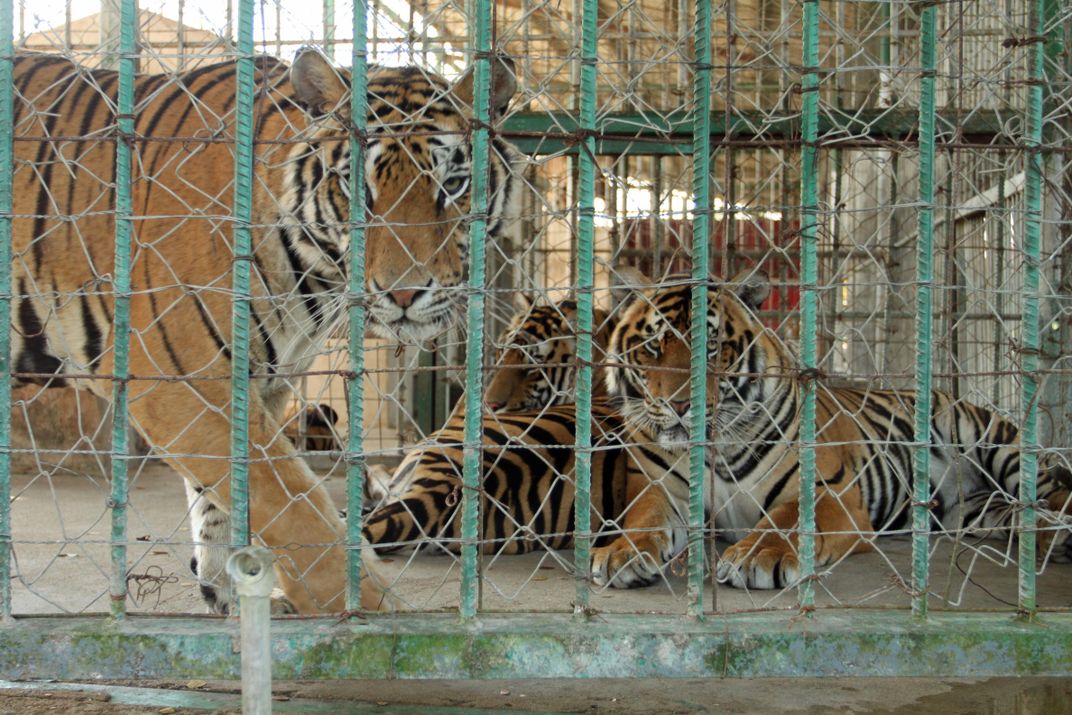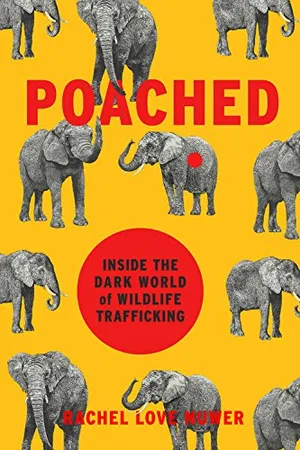Rhino Horn and Tiger Wine: How the Illegal Wildlife Trade Is Growing Bolder
Wildlife author and journalist Rachel Nuwer discusses her new book Poached about one of the world’s fastest-growing contraband industries
:focal(2369x1579:2370x1580)/https://tf-cmsv2-smithsonianmag-media.s3.amazonaws.com/filer/ee/c6/eec6d632-14b0-4d22-8020-6227f0bcf9a0/img_7080.jpg)
Wildlife trafficking is the vast criminal network expanding in plain sight. Illicit animal products are increasingly for sale in store windows and on public websites, mocking would-be prosecutors. While law enforcement agencies focus their efforts on quelling the sale of drugs and weapons, poachers and exotic animal traders have quietly grown wildlife trafficking into a global industry worth $7 to $23 billion annually.
“The world is dealing with an unprecedented spike in illegal wildlife trade,” according to the World Wildlife Fund. But the WWF's warning doesn’t capture the full picture of gangs and terrorist organizations fueling the shady business. An unethical buyer can purchase illicit ivory, rare lizards, whole tiger skeletons or even a live bear ready to be butchered and cooked to the diner’s preference.
Demand is on the rise—in China, the wholesale price of a pound of ivory jumped from $55 in 2002 to $955 in 2014—sapping the world’s supply of biodiversity. Illegal wildlife sales are largely responsible for putting more than 130 indigenous Southeast Asian animals onto the critically endangered list. While an aggressive (and at times deadly) anti-poaching campaign in Chad’s Zakouma National Park has produced what’s likely Central Africa’s largest elephant heard, poaching across the rest of the continent has contributed to the death of 144,000 savannah elephants between 2007 and 2014—30 percent of the animal’s population.
“Illegal wildlife trade, like drugs or human trafficking, is a truly global problem, impacting nations, animals and people all over the world,” says journalist and author Rachel Nuwer. For nearly two years, Nuwer travelled the world to see the black market of wildlife trade firsthand, chronicling her experiences in a new book, Poached: Inside The Dark World Of Wildlife Trafficking, available September 25.
Smithsonian.com spoke to Nuwer to learn about her new book and the increasing threat of wildlife trafficking.
The illegal wildlife trade has grown substantially in recent years. What attracts criminal organizations to it, and why is it so lucrative?
Like any other criminal enterprise, money drives the illegal wildlife trade. It’s a multi-billion-dollar business, estimated to be the world’s third or fourth biggest contraband market. Yet compared to drugs and arms trafficking, it receives scant attention. It’s not taken that seriously by many lawmakers and law enforcers, and the punishments for engaging in it are usually really weak. Prosecution rates for those who are caught are also very low.
In other words, it’s low risk, high reward—for criminals, it’s a great industry to be in.
Poached: Inside the Dark World of Wildlife Trafficking
Journalist Rachel Nuwer plunges the reader into the underground of global wildlife trafficking, a topic she has been investigating for nearly a decade.

How does the illegal sale of wildlife goods compare to other contraband markets?
Unlike those dealing in other criminal goods, illegal wildlife traders oftentimes don’t even hide what they’re selling. They post photos of baby orangutans directly on Facebook and openly display ivory in their shops. A study came out a couple years ago showing that, contrary to drugs, counterfeit goods and arms, illegal wildlife trade has yet to move onto the dark web—most likely because it doesn’t have to.
Another difference is the stakes. When demand for drugs or counterfeit goods goes up, criminals can increase production. They can grow more cocaine, for example, or make more fake Chanel bags. When demand for wildlife outstrips supply, however, that ultimately means extinction for the species involved.
You wrote about how traffickers exploited a loophole in legal rhino hunting to create what’s known as a pseudo-hunting ring, and you spoke to a Thai man in a South African prison who pled guilty to 52 counts of contravening South Africa's customs and environmental laws while leading one of these rings for one of the wildlife trade’s most infamous criminal networks. Did you get the impression that he realizes the impact he's had on the rhino population?
Chumlong Lemtongthai, who was actually released from prison this month and sent home to Thailand, and his colleagues were responsible for the deaths of up to 50 rhinos, if not more. Chumlong, however, doesn’t think he did anything wrong. As he emphasized to me, he paid for the permits to shoot the rhinos and filed the paperwork to export the trophies. He also always targeted more populous white rhinos rather than critically endangered black rhinos. I don’t think Chumlong thought at all about the animals he killed. For him, the only impact that resonated was the impact to his freedom and wealth.
This industry is driven in part by animal-based traditional health and wellness treatments, even though there is a little evidence that these products are effective. Why do people still turn to them?
One source compared it to religion in some way. For true believers, you don’t need evidence that God exists; you just believe it. That’s the point, you have faith. For some people, wildlife products used in traditional medicine approach that level of faith-based beliefs. If you get scientific evidence from a Western system saying, “Oh that cure you’ve been using your whole life doesn’t work,” you’re just going to think, “Whatever, I know it works.” The placebo effect can be really strong.
/https://tf-cmsv2-smithsonianmag-media.s3.amazonaws.com/filer/90/d7/90d79f3c-50da-4cb3-875a-92e33fb8f81e/img_8952.jpg)
How should we communicate that these treatments are harmful to wildlife and sometimes even to their users?
It really depends on which user group you’re taking about. Take rhino horn. There are wealthy guys who take it out when they go drinking. They grind it up and take a shot of it, supposedly to prevent a hangover. Having talked to some of these people, they actually know that it doesn’t work. They just do it because it’s a cool status thing that makes them seem powerful.
I don’t think that appealing to people’s sentiments works in that context just because of different values. I had people tell me to my face, “I don’t care if rhinos go extinct.” So for the older, wealthy male crowd, people think the best strategy would be something like the anti-drunk driving campaigns that we see here, using fear and social shame.
While researching for Poached, you met all kinds of wildlife, including Sudan, the last male northern white rhino. Is there a certain species that’s close to your heart?
Definitely pangolins. I first learned about pangolins as a student doing my ecology degree because they’re really endangered in Vietnam. I was studying there, so I heard all about these weird, scaly mammals.
Their situation is pretty dire because they are currently the world’s most trafficked mammal. We have no idea how many are actually left in the wild. We do know from hunters that pangolins are becoming rarer and rarer where they used to be abundant, and traffickers have turned to sources of pangolins in Africa now because they’re becoming so rare in Asia, so that’s pretty chilling evidence.
I’d only ever seen them very briefly before when I visited a rescue center in Vietnam. So, to have boxes of pangolins right in front of me, and not only that, to be releasing them into the forest, was just a lovely feeling.
/https://tf-cmsv2-smithsonianmag-media.s3.amazonaws.com/filer/f0/42/f042d442-d967-459d-b4b6-c7afdf0082a7/img_8630.jpg)
Besides the obvious like not buying wildlife products, what can people do to help stop the illegal trade of wildlife?
Don't go to the tiger shows in Thailand. Maybe don't swipe right on that guy on Tinder posing with the tiger cub—yeah, those cubs are cute, but when they grow up they're likely going to be turned into tiger wine. Don't like things on social media that involve the wildlife trade or the misuse of wild animals, such as videos of wildlife being kept as pets. Instead, share stories that you see about the illegal wildlife trade.
If you're really motivated, you can contact your government representative or write to, say, the Indonesian consul in Washington D.C. You could also donate to the people on the ground who are doing great things. There are very big, well-known NGOs who do high-level work, but there are also people like Thai [Van Nguyen], who runs the pangolin rescue center, and they could really use money to keep doing their work.
Rachel Nuwer's new book, Poached, Inside the Dark World of Wildlife Trafficking, will go on sale on Tuesday, September 25.
A Note to our Readers
Smithsonian magazine participates in affiliate link advertising programs. If you purchase an item through these links, we receive a commission.
